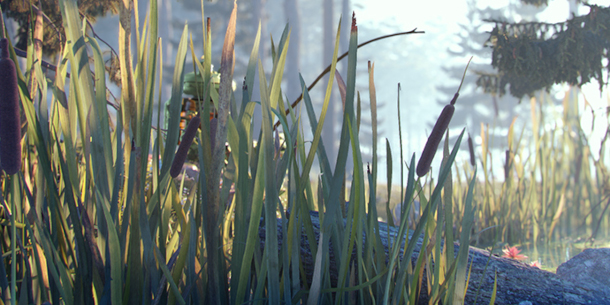Chaos ships V-Ray 5 for Maya Update 2
Originally posted on 18 June 2021. Scroll down for news of Update 2.
Chaos has updated V-Ray 5 for Maya, the Maya edition of the renderer, adding support for USD workflows.
Update 1 also adds a new progressive caustics system, support for Cryptomatte elements in progressive renders, new masking options in the V-Ray Frame Buffer, and integrates Intel’s Open Image Denoise.
Update 2 adds a new decal system, and updates V-Ray’s dirt and hair materials.
Initial support for USD-based visual effects workflows
Along with V-Ray for Houdini, V-Ray for Maya becomes the first version of the renderer to support VFX workflows based around Pixar’s Universal Scene Description (USD).
Artists can load USD files in Maya via the new Maya USD plugin bundled with the software in Maya 2022, and render them in V-Ray with mayaUsdProxy nodes.
The initial implementation supports static and animated meshes – both transformations and deformations – and V-Ray materials, textures, displacement and subdivision encoded into USD files.
Motion blur is supported, though it isn’t currently possible to render hair or particles from USD files.
Users can also export .vrscene files from V-Ray for Maya and render them in V-Ray Standalone, although it isn’t currently possible to export V-Ray lights or all types of displacement.
You find more details on the features currently supported in the online documentation.

Update 1: new Opacity Cutout tool converts opacity-mapped textures to cutout geometry
In addition, V-Ray 5 for Maya Update 1 introduces a new Opacity Cutout tool, which converts low-poly geometry with opacity-mapped textures into actual cutout geometry, reducing render times.
The workflow, which is intended mainly for use with opacity-mapped leaves on 3D plants, preserves instances, transformation and deformation, but currently only works with native Maya meshes.
New materials, lighting, rendering and post-processing features
The other new features in the release were originally introduced in V-Ray 5 for 3ds Max Update 1 earlier this year, so you can read about them in more detail in our original story.
They include updates to the way that translucency is handled in VRayMtl, the standard V-Ray Material, and support for coloured transparency in VRayEnvironmentFog.
In addition, Maya users now have access to the library of over 500 readymade real-world materials introduced with V-Ray 5 for 3ds Max.
There is also a new system for calculating caustics progressively, without the need to pre-calculate photon maps; and dome lights can be combined additively within a scene.
For CPU rendering, Open Image Denoise (OIDN), Intel’s CPU-based render-denoising system, is now integrated in V-Ray.
For GPU rendering, all of the features supported by V-Ray GPU are now available out of core – when rendering scenes larger than fit into GPU memory – and the V-Ray light cache is now calculated on the GPU.
Artists can also now use any of V-Ray’s masking render elements – Cryptomatte, MultiMatte and ID passes – as masks in the V-Ray Frame Buffer, and Cryptomatte elements are now supported in progressive renders.
Updated 12 November 2021: Chaos has released V-Ray for Maya Update 2.
The update extends USD support, adding the option to render USD lights, and to export V-Ray lights to USD.
New features include V-Ray Decal, a new system first introduced in the 3ds Max edition of the renderer for projecting textures onto surfaces in a scene without the need to set up or modify UVs for a mesh.
Users can control where the decal texture appears in the scene by using a viewport gizmo to adjust its position, size and angle; and can selectively exclude scene objects from the texture projection.
Other changes include new Sharpen/Blur controls when editing rendered images inside the V-Ray Frame Buffer, and improvements to V-Ray Dirt, the VRayNextHairMtl hair material and the V-Ray Curvature texture.
Outside the core software, Chaos Cosmos, Chaos’s new online library of architectural assets, is now available for Maya users.
Cloud rendering service Chaos Cloud now supports batch rendering of render layers and cameras.
Pricing and system requirements
V-Ray 5 for Maya Update 2 is available for Maya 2018+, running on Windows 8.1+, RHEL/CentOS Linux and Mac OS X 10.11+.
A perpetual workstation licence and one render node costs $1,180. Rental costs $80/month or $470/year.
Read an overview of the new features in V-Ray 5 for Maya Update 2 on the product website
Read a full list of new features in V-Ray 5 for Maya Update 2 in the online release notes
